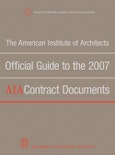This guide is divided into two parts:Part One, The AIA Standard Documents, examines the role of AIA Contract Documents, their history, and how the documents are written and updated. It also reviews the educational and supporting resources that are part of the AIA′s contract documents program; Part Two, The AIA Documents Companion, describes agreements in detail, including the purpose and rationale for provisions. Separate chapters cover the owner–contractor, contractor–subcontractor, owner–architect, and architect–consultant agreements. The guide concludes with a chapter describing pivotal legal cases that have helped shape and interpret AIA contracts.
Samples of the most commonly used contracts are in print in the appendix, and an accompanying CD–ROM has samples of all AIA Contract Documents (in PDF format for Mac and PC computers) that released in 2007, as well as the Integrated Project Delivery Family of documents that released in 2008. This book is invaluable for construction project owners, attorneys, contractors, subcontractors, design professionals, and others involved in the procurement, management, and delivery of building projects. It is also recommended for students and young professionals seeking a degree, certification, or licensure.
Table of Contents
Foreword.Preface.
Acknowledgments.
PART ONE: THE AIA STANDARD DOCUMENTS.
1. Introduction: Standardization of Construction Contracts.
1.1 Freedom of contract: the concept of private law–making .
1.2 Construction contract documentation.
1.3 The AIA Documents as a management tool.
1.4 The AIA Documents as a model.
1.5 The AIA Documents as an industry standard.
1.6 The AIA Documents as a legal standard.
2. History of the AIA Documents.
2.1 1860–1910: the precursors.
2.2 1910–1950: the turbulent years––prosperity, depression, and war.
2.3 1950–1990: drivers of the AIA Documents in the modern business age.
2.4 1990 to the present: the post–industrial age and the world economy.
3. The 2007 AIA Documents Development Process.
3.1 Governing factors.
3.2 Drafting principles.
3.3 The participants.
3.4 The drafting process.
4. The Documents Families Described.
4.1 The numbering system and the concept of document families.
4.2 The conventional (A201) family AIA s core documents.
4.3 Additional and supporting documents and guides.
4.4 Administrative forms (G–series documents).
4.5 The interiors family.
4.6 The construction management families.
4.7 The design–build family.
4.8 Small project documents.
4.9 International documents.
4.10 Digital practice documents.
4.11 The integrated project delivery family.
5. Educational and Supporting Resources.
5.1 Instructions.
5.2 Articles and publications.
5.3 The Architect s Handbook of Professional Practice.
5.4 Comparisons and commentaries.
5.5 Educational programs at the national and component level.
5.6 Staff assistance.
5.7 For lawyers: the AIA Legal Citator.
5.8 Third party resources: articles, conferences, and texts.
PART TWO: THE AIA DOCUMENTS COMPANION.
6. Basic Principles and Provisions.
6.1 Common terminology.
6.2 Dispute resolution.
6.3 Risk allocation.
7. Owner–Contractor Agreement Forms.
7.1 The AIA Document Families and the 2007 editions of the Owner–Contractor Agreement Forms.
7.2 Provisions of the Owner–Contractor agreement forms.
8. The General Conditions of the Contract for Construction.
8.1 Introduction: the 2007 editions of the General Conditions.
8.2 Provisions of the General Conditions.
9. Guide forms.
9.1 Guides for supplementary conditions and document amendments.
9.2 Owner s instruction forms.
10. The Subcontract Forms.
10.1 The AIA subcontract forms.
10.2 Provisions of the subcontract forms.
11. Procurement, Construction Administration and Other Standard Forms.
11.1 Preconstruction and procurement forms.
11.2 Construction administration forms.
11.3 Contract completion and closeout forms.
11.4 Architect s office administration forms.
12. Owner–Architect Agreement Forms.
12.1. The AIA Document Families and the 2007 editions of the Owner–Architect Agreement Forms.
12.2 Provisions of the standard Owner–Architect agreement forms.
13. Architect–consultant agreement forms.
13.1 The standard Architect–Consultant agreement form: AIA Document C401?–2007.
13.2 Provisions of the Architect–Consultant form.
14. Leading Cases Shaping and Interpreting the AIA Contract Documents.
14.1 The early legal landscape.
14.2 Cases construing the Uniform Contract.
14.3 The middle years––1915 to 1955.
14.4 Liability cases that influenced the documents in the 1960 s and 1970 s.
14.5 Topical cases.
14.6 Special risk allocation cases.
Appendices.
A. List of Illustrative Cases Interpreting the AIA Contract Documents.
B. AIA Document Synopsis by Family.
C. AIA Contact Documents.
A101–2007.
A201–2007.
A401–2007.
B101–2007.
C401–2007.
Index.
Samples

LOADING...








